Articles
- Page Path
- HOME > J Musculoskelet Trauma > Volume 20(2); 2007 > Article
-
Original Article
- Comparison of Operative Methods between Retrograde and Antegrade Nailing for Ipsilateral Femoral Shaft and Neck Fracture
- Chang-Wug Oh, M.D., Jong-Keon Oh, M.D., Woo-Kie Min, M.D., Shin-Yoon Kim, M.D., Seung-Hoon Baek, M.D., Byung-Chul Park, M.D., Hyung-Soo Ahn, M.D., Tae-Gong Kim, M.D.
-
Journal of the Korean Fracture Society 2007;20(2):135-140.
DOI: https://doi.org/10.12671/jkfs.2007.20.2.135
Published online: June 14, 2016
Department of Orthopedic Surgery, School of Medicine, Kyungpook National University, School of Medicine, Seoul, Korea.
*Department of Orthopedic Surgery, School of Medicine, Korea University, Seoul, Korea.
**Department of Anatomy, School of Medicine, Kyungpook Natiorial University, Daegu, Korea.
- Address reprint requests to: Chang-Wug Oh, M.D. Department of Orthopaedic Surgery, School of Medicine, Kyungpook National University, 101, Dongin-dong 2-ga, Jung-gu, Deagu 700-422, Korea. Tel: 82-53-420-5630, Fax: 82-53-422-6605, cwoh@knu.ac.kr
Copyright © The Korean Fracture Society. All rights reserved
- 144 Views
- 1 Download
- 3 Crossref
Figure & Data
REFERENCES
Citations
Citations to this article as recorded by 

- Surgical management of bifocal femoral fractures: a systematic review and pooled analysis of treatment with a single implant versus double implants
J. D. Cnossen, Esther M. M. Van Lieshout, Michael H. J. Verhofstad
Archives of Orthopaedic and Trauma Surgery.2023; 143(10): 6229. CrossRef - Retrograde Intramedullary Nailing or the Treatment of Segmental Femoral Shaft Fracture Including Distal Part
Jong-Ho Yoon, Byung-Woo Ahn, Chong-Kwan Kim, Jin-Woo Jin, Ji-Hoon Lee, Hyun-Ku Cho, Joo-Hyun Lee
Journal of the Korean Fracture Society.2009; 22(3): 145. CrossRef - The Treatment of IM Nailing of Femoral Shaft Fracture: Piriformis Fossa versus Trochanteric Entry Portal
Hyun Kook Youn, Oog Jin Shon, Dong Sung Han
Journal of the Korean Fracture Society.2008; 21(3): 200. CrossRef
Comparison of Operative Methods between Retrograde and Antegrade Nailing for Ipsilateral Femoral Shaft and Neck Fracture
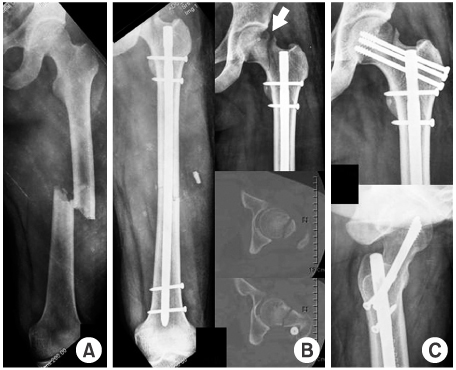
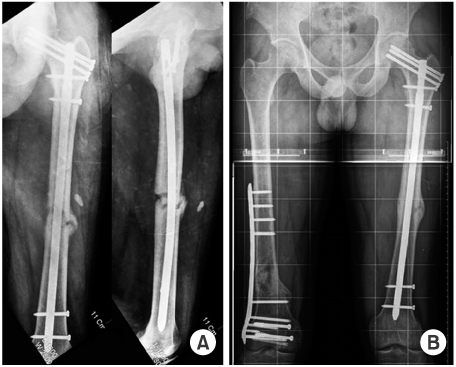
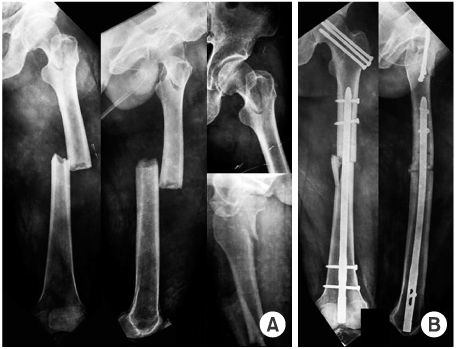
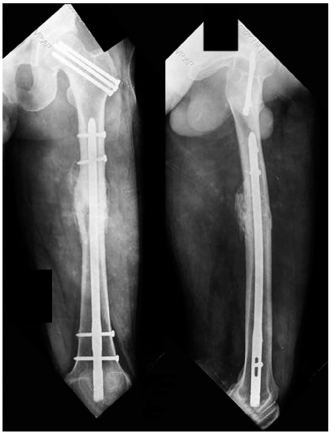
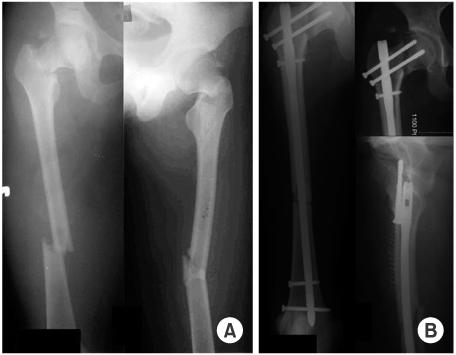
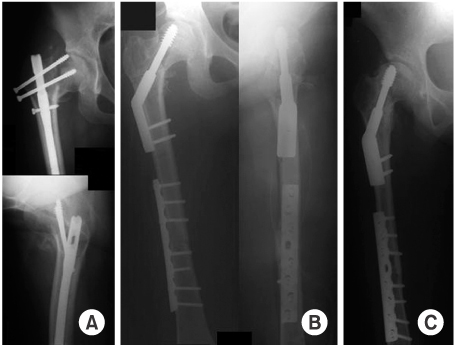
Fig. 1
(A) A 29-year-male with femur shaft fracture.
(B) Postoperatively, femur neck fracture was found on the radiograph (arrow) and CT image.
(C) Fourteen days after initial operation, fixation was done with three screws anterior to the femoral nail.
Fig. 2
(A) At 2 month, femoral neck fracture healed and callus is forming on the shaft fracture.
(B) At 6 month, all fractures healed uneventfully without leg length discrepancy.
Fig. 3
(A) A 61-year-man with ipsilateral fractures of femoral shaft and neck.
(B) Retrograde nailing of the shaft and screw fixation of the neck was done.
Fig. 4
At 5 month, fractures healed uneventfully.
Fig. 5
(A) 24 years old female with femur shaft fracture and ipsilateral displaced neck fracture.
(B) Antegrade nailing and screw fixation of the neck was done. Due to the preinserted nail, there were some difficulties in screw fixation.
Fig. 6
(A) At 3 months after surgery, the neck fracture displaced with loosening of the screws.
(B) Using dynamic hip screw and dynamic compression plate, revision procedure was done on both fractures.
(C) At 7 month after 2nd operation, both fractures healed.
Fig. 1
Fig. 2
Fig. 3
Fig. 4
Fig. 5
Fig. 6
Comparison of Operative Methods between Retrograde and Antegrade Nailing for Ipsilateral Femoral Shaft and Neck Fracture

 E-submission
E-submission KFS
KFS






 Cite
Cite

